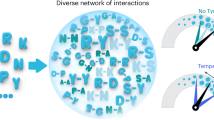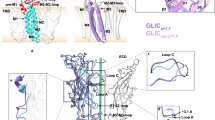Abstract
Marked hydration changes occur during the self-assembly of the melittin protein tetramer in water. Hydrophobicity induces a drying transition in the gap between simple sufficiently large (more than 1 nm2) strongly hydrophobic surfaces as they approach each other1,2,3,4,5,6, resulting in the subsequent collapse of the system, as well as a depletion of water next to single surfaces7,8,9,10. Here we investigate whether the hydrophobic induced collapse of multidomain proteins or the formation of protein oligimers exhibits a similar drying transition. We performed computer simulations to study the collapse of the tetramer of melittin in water, and observed a marked water drying transition inside a nanoscale channel of the tetramer (with a channel size of up to two or three water-molecule diameters). This transition, although occurring on a microscopic length scale, is analogous to a first-order phase transition from liquid to vapour. We find that this drying is very sensitive to single mutations of the three isoleucines to less hydrophobic residues and that such mutations in the right locations can switch the channel from being dry to being wet. Thus, quite subtle changes in hydrophobic surface topology can profoundly influence the drying transition. We show that, even in the presence of the polar protein backbone, sufficiently hydrophobic protein surfaces can induce a liquid–vapour transition providing an enormous driving force towards further collapse. This behaviour was unexpected because of the absence of drying in the collapse of the multidomain protein 2,3-dihydroxybiphenyl dioxygenase (BphC).
This is a preview of subscription content, access via your institution
Access options
Subscribe to this journal
Receive 51 print issues and online access
$199.00 per year
only $3.90 per issue
Buy this article
- Purchase on Springer Link
- Instant access to full article PDF
Prices may be subject to local taxes which are calculated during checkout



Similar content being viewed by others
References
Ball, P. How to keep dry in water. Nature 423, 25–26 (2003)
Wallqvist, A. & Berne, B. J. Computer simulation of hydrophobic hydration forces on stacked plates at short range. J. Phys. Chem. 99, 2893–2899 (1995)
Hummer, G., Rasaiah, J. R. & Noworyta, J. P. Water conduction through the hydrophobic channel of a carbon nanotube. Nature 414, 188–190 (2001)
Leung, K., Luzar, A. & Bratko, D. Dynamics of capillary drying in water. Phys. Rev. Lett. 90, 065502 (2003)
Huang, X., Margulis, C. J. & Berne, B. J. The dewetting and collapse of nanoscale hydrophobic objects. Proc. Natl Acad. Sci. USA 100, 11953–11958 (2003)
Huang, X., Zhou, R. & Berne, B. J. Drying and hydrophobic collapse of paraffin plates. J. Phys. Chem. B 109, 3546–3552 (2005)
Stillinger, F. H. Structure in aqueous solutions of nonpolar solutes from the standpoint of scaled-particle theory. J. Solution Chem. 2, 141–158 (1973)
Lum, K., Chandler, D. & Weeks, J. D. Hydrophobicity at small and large length scales. J. Phys. Chem. B 103, 4570–4577 (1999)
Chandler, D. Two faces of water. Nature 417, 491 (2002)
Sansom, M. S. P. & Biggin, P. C. Biophysics: water at the nanoscale. Nature 414, 156–159 (2001)
Zhou, R., Huang, X., Margulius, C. J. & Berne, B. J. Hydrophobic collapse in multidomain protein folding. Science 305, 1605–1609 (2004)
Shea, J., Onuchic, J. & Brooks, C. L. Probing the folding free energy landscape of the src-SH3 protein domain. Proc. Natl Acad. Sci. USA 99, 16064–16068 (2002)
Cheung, M. S., Garcia, A. E. & Onuchic, J. Protein folding mediated by solvation: water expulsion and formation of the hydrophobic core occur after the structural collapse. Proc. Natl Acad. Sci. USA 99, 685–690 (2002)
Wolde, P. R. T. & Chandler, D. Drying-induced hydrophobic polymer collapse. Proc. Natl Acad. Sci. USA 99, 6539–6543 (2002)
Cheng, Y. & Rossky, P. J. Surface topography dependence of biomolecular hydrophobic hydration. Nature 392, 696–699 (1998)
Steitz, R. et al. Nanobubbles and their precursor layer at the interface of water against a hydrophobic substrate. Langmuir 19, 2409–2418 (2003)
Jensen, T. R. et al. Water in contact with extended hydrophobic surfaces: Direct evidence of weak dewetting. Phys. Rev. Lett. 90, 086101 (2003)
Terwilliger, T. C. & Eisenberg, D. The structure of melittin. J. Biol. Chem. 257, 6010–6015 (1982)
Jorgensen, W. L., Maxwell, D. & Tirado-Rives, J. Development and testing of the OPLS all-atom force field on conformational energetics and properties of organic liquids. J. Am. Chem. Soc. 118, 11225–11236 (1996)
Lindahl, E., Hess, B. & van der Spoel, D. Gromacs 3.0: A package for molecular simulation and trajectory analysis. J. Mol. Model. 7, 306–317 (2001)
Acknowledgements
We thank J. Castanos and his team for providing the running environment, and M. Eleftheriou, B. Walkup and A. Royyuru for help and support with the BlueGene/L machine. This work was supported in part by an NIH grant and an IBM SUR grant to B.J.B.
Author information
Authors and Affiliations
Corresponding authors
Ethics declarations
Competing interests
Reprints and permissions information is available at npg.nature.com/reprintsandpermissions. The authors declare no competing financial interests.
Supplementary information
Supplementary Notes
Supplementary Figures S1-S3 and a Supplementary Note are provided in the supporting material. Supplementary Figure S1: more trajectories for the number of water molecules inside the channel of melittin tetramer versus the MD simulation time. Supplementary Figure S2: more trajectories for the number of water molecules inside the channel of mutated melittin tetramer (single mutations). Supplementary Figure S3: the number of water molecules inside the melittin tetramer channel versus the dimer-dimer separation distance during the collapse of the tetramer. The Supplementary Note describes simulation of the melittin tetramer in its 'crystal environment'. (DOC 580 kb)
Rights and permissions
About this article
Cite this article
Liu, P., Huang, X., Zhou, R. et al. Observation of a dewetting transition in the collapse of the melittin tetramer. Nature 437, 159–162 (2005). https://doi.org/10.1038/nature03926
Received:
Accepted:
Issue Date:
DOI: https://doi.org/10.1038/nature03926
This article is cited by
-
Initial growth dynamics of 10 nm nanobubbles in the graphene liquid cell
Applied Nanoscience (2021)
-
Dewetting in associating lattice gas model confined by hydrophobic walls
Science China Physics, Mechanics & Astronomy (2019)
-
Effect of Na and Cl ions on water evaporation on graphene oxide
Nuclear Science and Techniques (2019)
-
Temperature effects on the hydrophobic force between two graphene-like surfaces in liquid water
Journal of Chemical Sciences (2018)
-
Dewetting Behavior of Hydrogen Bonded Polymer Complex Film under Hydrothermal Condition
Chinese Journal of Polymer Science (2018)
Comments
By submitting a comment you agree to abide by our Terms and Community Guidelines. If you find something abusive or that does not comply with our terms or guidelines please flag it as inappropriate.



